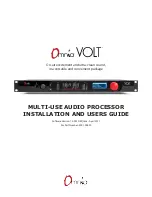
11
Operating Manual-4048A digital signal processor
Parametric EQ (PEQ): uses peak filters with the ability to control boost or cut, frequency center, and band-
width. Think of one band of parametric EQ as a single graphic equalizer fader except that the frequency is variable,
not fixed, and that the bandwidth, or how "wide" the filter affects the frequency spectrum at the center frequency, is
completely variable. The smaller the bandwidth, the less the audio signal on either side of the frequency center is
boost or cut, whereas a larger "wider" bandwidth produces an audible change to the overall tone of a signal. Paramet-
ric filters are best used to hunt down and eliminate problem feedback frequencies, add or remove a characteristic "hot
spot" from microphones, or clean up room resonance situations. It is well worth the time becoming proficient with
parametric EQ filters, as they offer the best solution to many EQ problems.
4048A parametric filters have a boost/cut range of +15dB to -30dB. There is more cut than boost because one
of the more common uses for parametric filters is to dramatically cut, or "notch out", very narrow frequencies (low
bandwidth) in order to eliminate system feedback problems.
Every instance of a parametric EQ filter has a center frequency selected. The factory default is 1kHz, but each
filter's center frequency is adjustable from 19.7Hz to 21.9kHz in 1/96 octave steps. Carefully sweeping a narrow
bandwidth filter through a problem feedback area, with just a slight boost, is a quick way to find the exact frequency
causing trouble. Once the offensive frequency has been found, cut the filter's level, and then adjust the bandwidth as
narrow as possible while still eliminating the feedback problem. Bandwidth is adjustable from about 1/64 octave to
four octaves, and the lower the bandwidth, the less audible the filter action will be. Finding the problem frequency is
relatively easy, but finding the best combination of cut and bandwidth takes a little practice. Again, it is well worth the
time getting comfortable with the notching procedure, so that problems can be quickly addressed with a sufficient but
minimal amount of correction.
200Hz
2KHz
20KHz
20Hz
0dB
-10dB
-20dB
+10dB
+20dB
-30dB
4048A Parametric Filters
Wide (High) Bandwidth
Narrow (Low) Bandwidth
7.3d EQ
Each input and output of the Altec Lansing 4048A
processor has its own EQ section offering full parametric EQ,
four types of shelving filters, and an all-pass filter. Input
channels have eight selectable EQ filters, while output chan-
nels have six selectable EQ filters. On all inputs and outputs,
each EQ filter is selectable between parametric (PEQ), 1st
order Low Shelf (LS1), 2nd order Low Shelf (LS2), 1st order
High Shelf (HS1), 2nd order High Shelf (HS2), and an All-
Pass filter (AP).






































